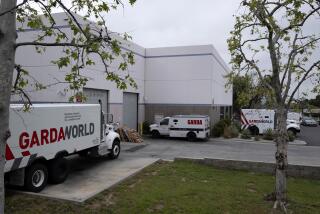O.C. Slaying Raises Fears for ATM Workers’ Safety
- Share via
ORANGE — As police identified the charred body in a burned-out Ford Escort as that of a man who serviced automated teller machines, banks and security firms on Monday began focusing on dangers to employees who stock the machines with cash and withdraw deposits.
Safety has long been a concern for customers pulling money out. With ATMs proliferating in airports, supermarkets and free-standing kiosks far from bank branches, the death of courier Robert T. Walsh has opened up a new frontier of security issues for employees of courier services.
“It’s going to be a growing concern over the next five to 10 years,” said Boris Melnikoff, director of security for Wachovia Corp., an Atlanta-based bank holding company and a member of the American Bankers Assn.’s security committee.
Walsh’s family began a fruitless search for the missing 58-year-old man on Friday after he failed to report in from his shift as a deposit puller for a national armored vehicle company. The family’s hopes were dashed on Monday when Orange Police Department officials confirmed that Walsh’s charred remains were inside the burned-out Ford Escort found Sunday in an alley behind a strip mall in Orange.
The death sparked speculation in the banking community that robbers mistakenly pegged Walsh as someone who was responsible for replenishing cash supplies for local ATMs.
“This isn’t your standard armored-car heist,” said one bank spokeswoman who asked not to be identified. “You’re not going to get cash, for the most part, from this kind of guy. It’s mostly just checks.”
ATM security has been an issue since the early 1970s when ATMs started to pop up around the country.
For consumers, who logged more than 7.7 billion ATM transactions during 1993, the issue is usually fear of being robbed while plucking cash from the seemingly ubiquitous machines.
But financial institutions that service the nation’s 95,000 ATMs now have additional worries. FBI and Orange County Sheriff’s Department officials were unsure if any agency gathers data on robberies of ATM service technicians, but none knew of any similar cases.
When ATMs were located at banks and thrifts, financial institutions replenished cash supplies from the safety of their own buildings. Smaller banks still prefer to keep their ATMs on the premises.
“We don’t have the problem of a courier going around,” said J.B. Crowell, president of Tustin-based Eldorado Bank. “We do our servicing from inside our (branches). Usually, we can handle it during non-bank hours in a secure building, so we have no problem with handling cash.”
However, larger financial institutions have responded to consumer demand for easy access to cash by installing ATMs wherever people congregate--in shopping centers, airports and amusement parks.
Such locations delight consumers but also make it more difficult to service ATMs. “And as it becomes more difficult,” Melnikoff said, “many institutions prefer to have (servicing) done by third parties . . . who assume the exposure.”
That was the case with Walsh, an employee of Atlanta-based Wells Fargo Armored Service Corp., which also owns Pony Express Courier Corp. and Burns International Security Service. Wells Fargo Armored is not related to Wells Fargo Bank, one of the financial institutions Walsh was servicing on Friday.
Like all Wells Fargo Armored employees who service ATMs, Walsh was required to wear a bullet-resistant vest, said company spokesman Joe Allen. Walsh was not required to carry a weapon, Allen said, because his deposit-retrieval route didn’t involve large amounts of cash.
Walsh’s car was equipped with a back-seat safe for deposits and a radio that linked him to the company’s La Habra office. Walsh also wore a beeper.
On Friday morning, Walsh evidently retrieved deposit envelopes from several ATMs and delivered them to local bank offices. But something went awry during the afternoon or early evening.
Allen said that Walsh, who joined the company in October, 1994, was carrying very little cash as he traveled along his regular Friday route, which Allen described as “very low liability” in contrast to company routes where armed guards transport money in armored cars.
While federal regulators establish guidelines for bank security, financial institutions and courier services generally craft their own guidelines when it comes to servicing and replenishing ATMs, Melnikoff said.
“Companies might use one person to replenish cash,” Melnikoff said. “Some companies use (two employees on) routes. It all depends upon the location and what the (company) wants to do.”
Financial institutions, fearful of compromising security programs, declined to comment on how they safeguard personnel who service ATMs.
Melnikoff said that banks and courier services must balance risk against the added cost of protecting employees who service ATMs and replenish them with cash.
“Some (banks) don’t service after dark, others might service to 10 or 11 at night,” Melnikoff said. “But some geographic locations need to be serviced 24 hours a day.”
Banks typically service ATMs located inside their branch offices, but many financial institutions prefer to turn over servicing of off-site locations to armed courier services, such as Wells Fargo Armored.
“It all depends upon the philosophy of the institution,” Melnikoff said. “When you’re using a third-party vendor, it’s their call how you make deliveries and pick up deposits. And, obviously, they assume the degree of liability and responsibility for doing that.”
Many banks and courier services demand that cash replenishment be handled by two armed personnel. “One remains in the vehicle and watches while the other one replenishes cash supplies or services the machine,” said Melnikoff.
And, despite much-publicized robberies of consumers at ATM kiosks, crimes against ATM personnel haven’t been as numerous.
* VICTIM MOURNED: Family praises Robert Walsh’s spirit of generosity. B1
(BEGIN TEXT OF INFOBOX / INFOGRAPHIC)
Cash on Demand
As the number of automated teller machines has increased, so has usage of them. There are about 149 million ATM cards in use nationwide, or about 1.6 per household, and 71% of adults have cards. How use has grown: Number of Machines 1993: 94,822 Total Transactions (in billions) 1993: $7.70 Source: American Bankers Assn.
More to Read
Sign up for Essential California
The most important California stories and recommendations in your inbox every morning.
You may occasionally receive promotional content from the Los Angeles Times.













